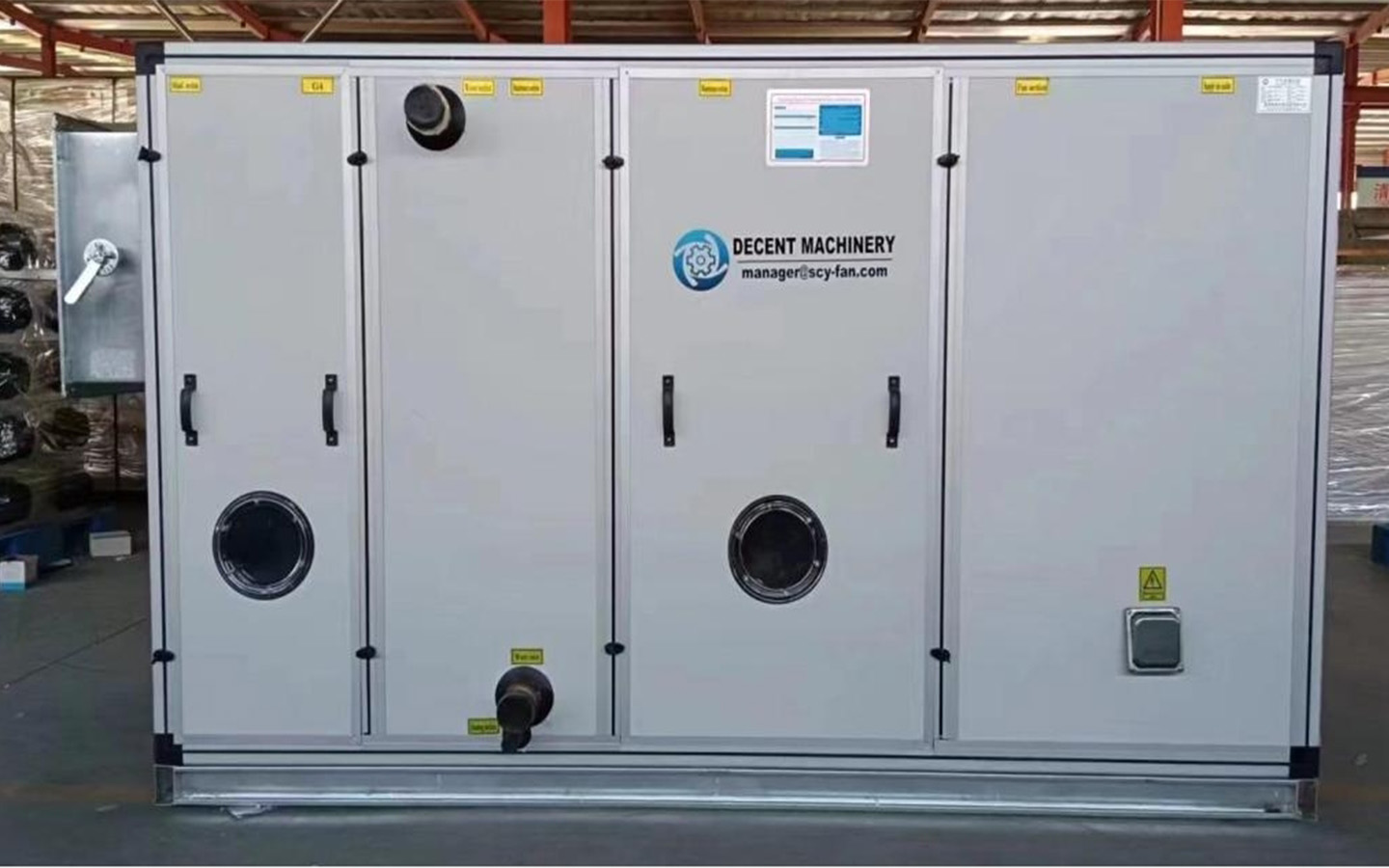
Key points for selecting a packaged air handling unit include compact size, multiple functions, low noise, low energy consumption, aesthetic design, and easy installation and maintenance. Designers can flexibly combine functional sections based on parameters such as cooling load, heating load, humidity load, supply air temperature, supply air humidity, and noise. However, due to the multiple functional sections and complex structure, it is necessary for designers and construction units to compare various aspects such as material, manufacturing process, structural characteristics, and selection calculations to achieve satisfactory results. The following points have been summarized from long-term market feedback and production experience:
1. Air filtration section
The function of the air filtration section is to filter out dust from the air. Dust in the air can have an impact on human health and product quality, particularly in certain industries such as precision instruments, electronics, pharmaceuticals, hospitals, etc., where air cleanliness requirements are extremely high. This requires the selection of a packaged air handling unit based on the specific requirements of each industry.
For air conditioning in comfortable environments, a certain degree of dust removal is required. The filtration section of such air handling units only needs to be equipped with primary and intermediate filters. For the above-mentioned special industries, high-efficiency filters must be added to achieve ultra-purification, which requires very high levels of purification. Primary filters include plate filters and bag filters made from nonwoven fabrics. Intermediate filters generally use bag filters made from nonwoven fabrics.
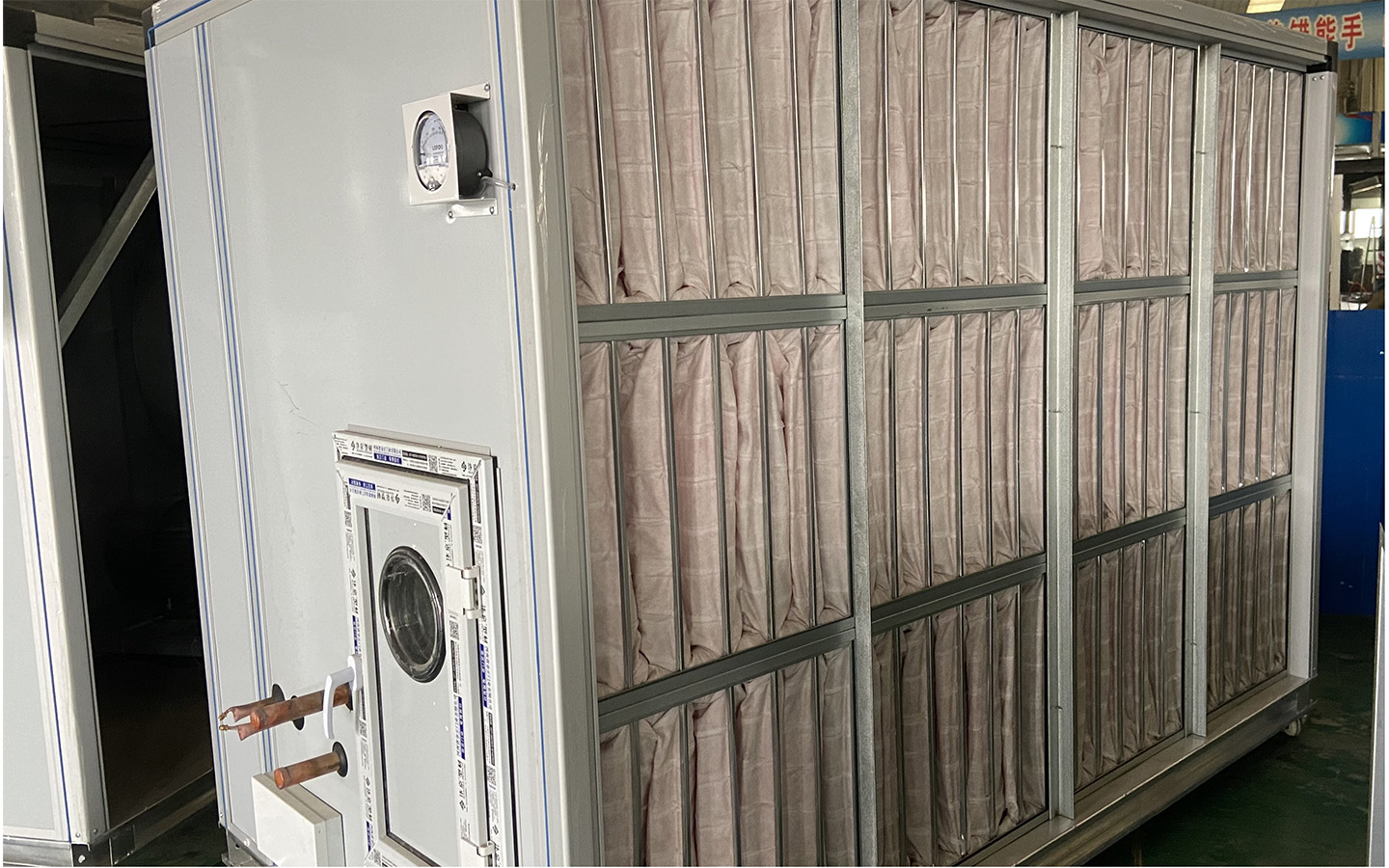
2. Surface cooler section
The surface cooler is the core component of a packaged air handling unit and is the place where air and refrigerant undergo heat exchange to cool and dehumidify the air. This section generally contains coils made of copper tubes with aluminum fins. Customers can select from coils with 4, 6, or 8 rows of tubes. The thickness of the copper tube walls and aluminum foil may vary slightly depending on the manufacturer, but generally the copper tube wall thickness is 0.2-0.6 mm with diameters of 7-16 mm, and the aluminum foil thickness is 0.15-0.20 mm. It should be noted that different manufacturers often use different spacing between fins for their surface coolers. As an example, for a system with an air flow rate of 79,000 m3/h and a cooling capacity of 831 kW, one company chose to reduce the spacing between fins (to about 1.8 mm) to increase the heat exchange area, while another company used conventional spacing (about 2.5 mm) and two levels of surface coolers in series to extend the heat exchange time. Each approach has its own advantages and disadvantages in terms of fan power consumption, water resistance, and section size. After thorough technical comparison and taking cost factors into account, the second company’s product was chosen. This example illustrates the importance of selecting the appropriate surface cooler calculation method to ensure the performance and overall cost-effectiveness of the packaged air handling unit.
The surface cooler entrance velocity generally should not exceed 2.5 m/s, as higher velocities can cause water droplets to be carried along with the cooled air, thereby increasing the air humidity. If the entrance velocity is >2.5 m/s, a water-blocking baffle is installed on the outlet side of the surface cooler to prevent water droplets from being carried along with the air.
3. Humidification Section
There are several methods for humidification, and there are various forms of humidification sections in packaged air handling units. Common methods of humidification include:
(1) Direct injection of steam into the air. Packaged air conditioning units currently use dry steam humidifiers, which can prevent water droplets from being carried along. The humidification is fast, even, stable, without water droplets, and the amount of humidification is easy to control. This method is suitable for places with strict humidity control but can only be used in buildings with a steam source.
(2) High-pressure spraying. Water is pressurized to 0.3-0.35MPa (gauge pressure), which results in the generation of water droplets with an average size of 20-30μm. The water droplets absorb heat and evaporate into the air. The advantages are a large humidification quantity, low noise, low power consumption, and low operation cost. The disadvantage is that water droplets may form, and impurities such as calcium and magnesium will precipitate when using untreated water. This is a commonly used humidification method in packaged air conditioning units.
(3) Wet film humidification. This method uses a humid material surface to evaporate water vapor into the air for humidification. The advantages are simple equipment structure, small volume, and filter dust on the filler layer. The filler layer also prevents water droplets from being mixed with air. The disadvantage is that the wet surface is prone to the growth of microorganisms, and the filler layer requires regular replacement.
(4) Vapor-permeable membrane humidification, which uses the principle of membrane distillation from chemical technology as a humidification technique, this method features a simple device structure, low operating cost, energy efficiency, and clean humidification.
(5) Other humidification methods include electric heating, infrared radiation, and centrifugal humidification.
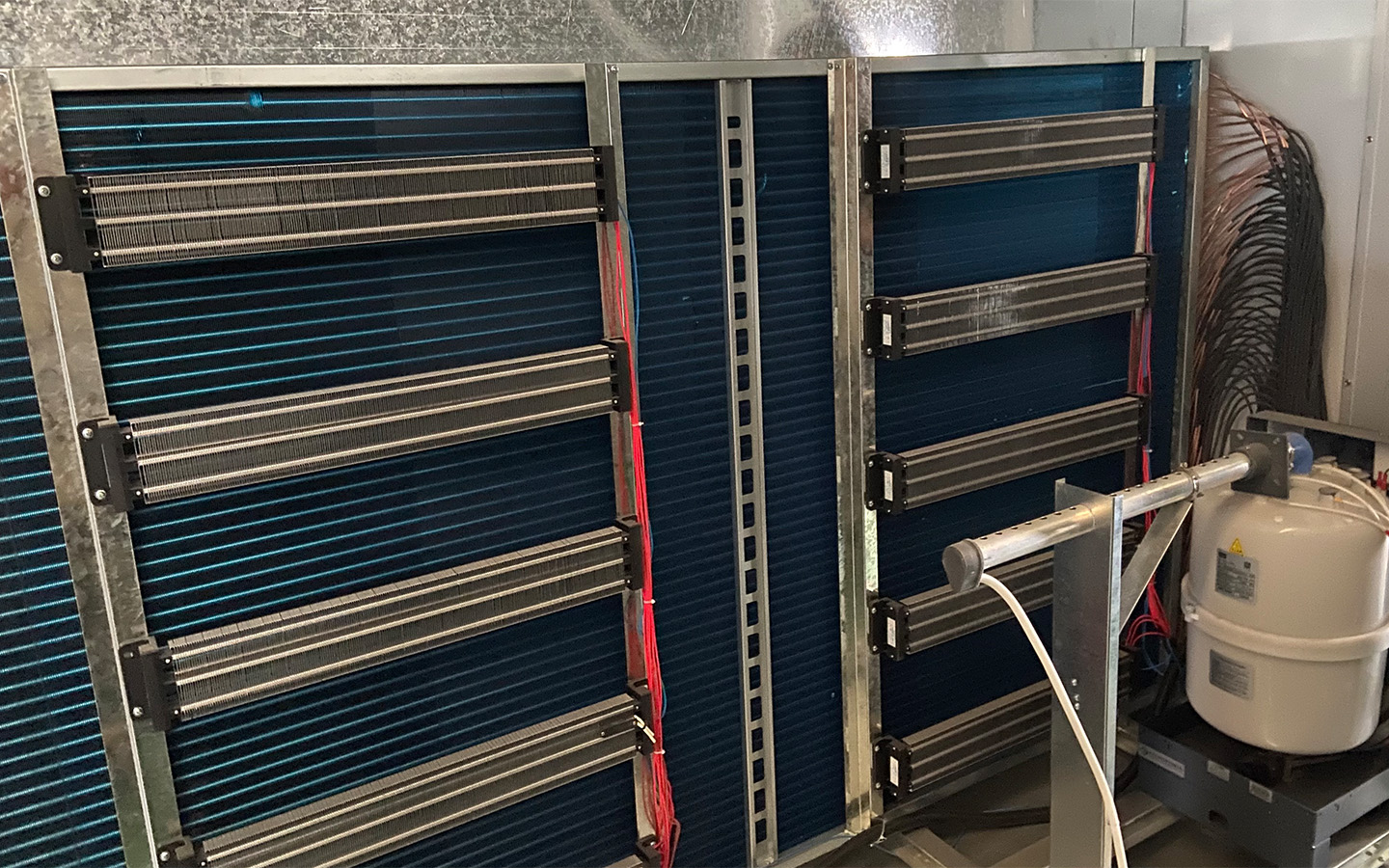
There are three types of heating coils: hot water coils, steam coils, and electric heaters. Hot water coils and cooling coils have the same structure but only come in one, two, or four rows of coils. The steam coil heat transfer component can be a copper tube wrapped around aluminum fins or a helically-wound tube, available in one or two rows.
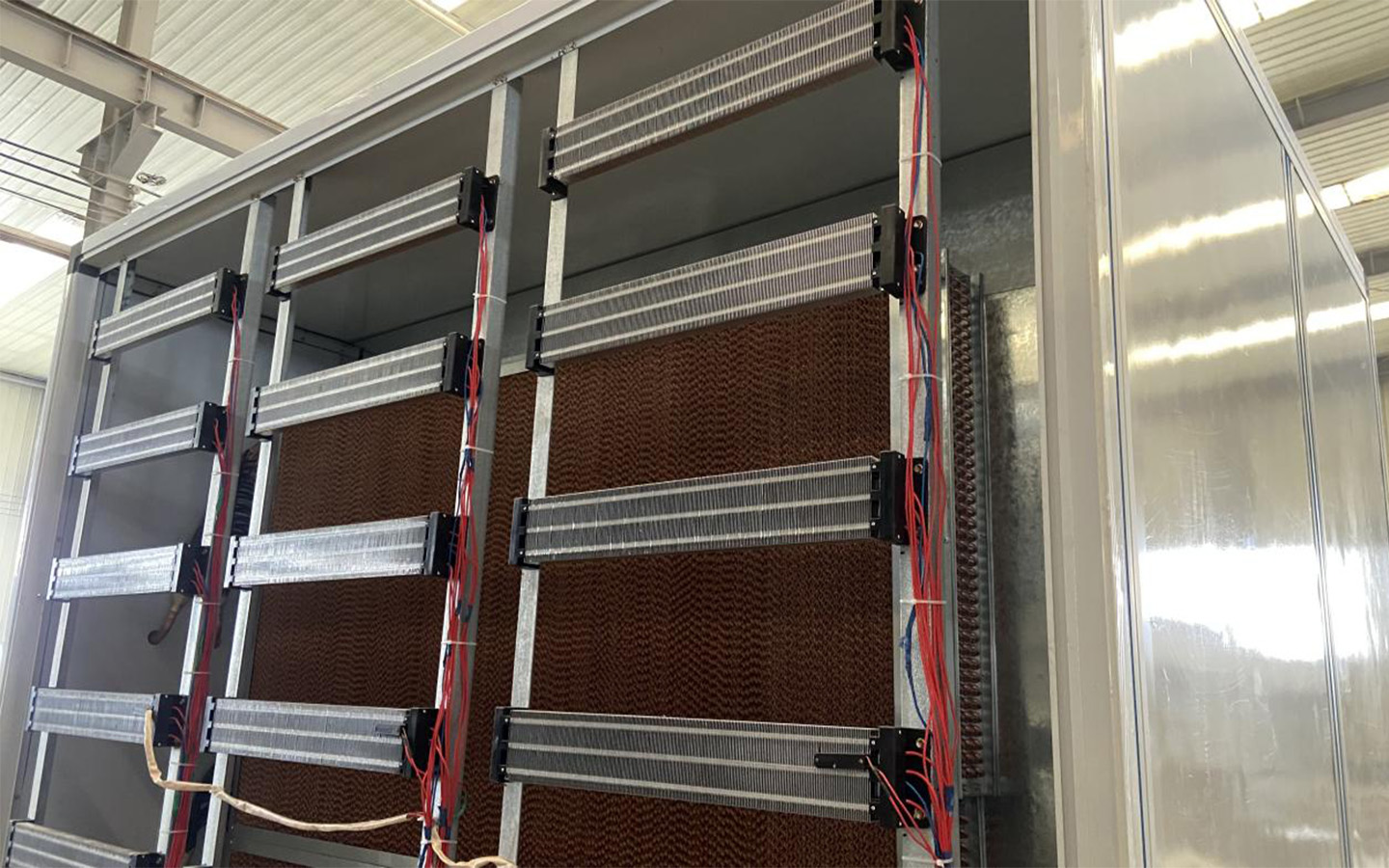
The fan is the only power-consuming part of the packaged air handling unit. As with general fans, the fan type, rotation speed, power, and motor should be selected based on the total air volume and total resistance required by the system. Typically, a backward-curved blade or forward-curved blade centrifugal fan is chosen, with a preference for the former due to efficiency and low noise. For systems that require high pressure, forward-curved blade fans are recommended.
With the development of technology and the increased level of automatic control, variable air volume systems are widely applied in office buildings, clean factories, hospitals, and other locations. This development has raised the demand for the fan selection of return air and supply air. Firstly, the fan’s characteristic curve should have a gentle character to ensure that the system avoids unnecessary static pressure increases when the air flow decreases. Secondly, when selecting the fan, it should operate within a stable and efficient range. Thirdly, the return or exhaust fan should be the same type as the supply fan, and the performance characteristics should be the same or similar, ensuring that the entire system runs effectively.
The return air duct interface is located on the box of the return air section. The supply air duct is typically connected to a splitter section. The return air is split, with some air discharged outside and some participating in the recycling process while fresh air is introduced into the system. The ratio of supply air, return air, and exhaust air is controlled by a damper.
6. Other functional sections
In addition to the main functional sections mentioned above, there are some auxiliary functional sections, mainly including:
(1) Mixed section – the upper and side parts of this section have air duct interfaces to connect to the return and fresh air ducts. The new/return air ratio can be adjusted through the air inlet damper.
(2) Middle section – this section has maintenance doors for maintenance and repair inside the unit. However, some manufacturers’ units have major equipment that can be pulled out, so a middle section is not necessary.
(3) Secondary return air section – this section has connection ports for return air.
(4) Noise reduction section – this section is used to reduce the noise generated by the fan.
7. Insulation performance
The wall panels of the air handling units are generally made of double-layer color-coated steel plates or cold-rolled steel plates powder-coated, with polyurethane foam or flame-retardant centrifugal glass wool as the insulation material. Both types of insulation materials have good thermal conductivity, water absorption, and density properties. However, since the air handling units operate with high-speed supply and return fans, and the unit vibrates significantly, the lightweight and porous structure of glass wool may cause it to fall off due to long-term vibration, resulting in a sharp increase in thermal conductivity, loss of insulation, and condensation on the wall panels of the air handling units, causing the supply air temperature to increase.
However, using polyurethane foam insulation does not necessarily guarantee good insulation performance. Poor quality polyurethane foam insulation materials may also affect the effectiveness of the unit. Therefore, when selecting air handling units, the insulation material of the wall panels should not be chosen lightly.
Most manufacturers of air handling units use a combination of panels and aluminum alloy or angle steel welded frames to form the structure of the unit. Sealing treatment of the unit is also an aspect that should be highly considered during selection, as excessive air leakage may result in two consequences: insufficient supply air volume due to excessive air leakage or air leakage in the negative pressure air handling room. In summer, this may cause untreated hot and humid air to enter the supply air system, causing the dew point to not meet the design requirements and the supply air temperature parameters cannot be guaranteed.
The manufacturing specifications for “Combined Air Conditioning Units” (GB/T14294-2008) state that “when the static pressure of the unit is maintained at 700Pa, the air leakage rate of the unit shall not exceed 3%”. Some manufacturers have a dovetail-type sealing groove on the frame of the air handling unit, with corresponding rubber sealing strips, which can ensure an air leakage rate of less than 2% under rated conditions, meeting the specifications requirements. This is a good way to solve the problem of air leakage in the unit.
9. Convenient maintenance
Considering the replacement, cleaning, and maintenance convenience of the functional segments of the combined air conditioning unit, a middle section should be added appropriately. In particular, for components that often require maintenance and cleaning such as cooling coils and filters, the middle section is even more necessary. However, sometimes the length of the air conditioning unit is limited due to the size of the air-conditioned room, and it is not possible to design an adequate middle section. When selecting the equipment, the manufacturer can be asked to improve the structure of the air handling unit according to the actual situation of the room, such as designing the cooling coil section and filter section to be removable from the side or installing a maintenance door in the upstream functional section. Additionally, during construction, care should be taken to reserve maintenance space and channels as much as possible.
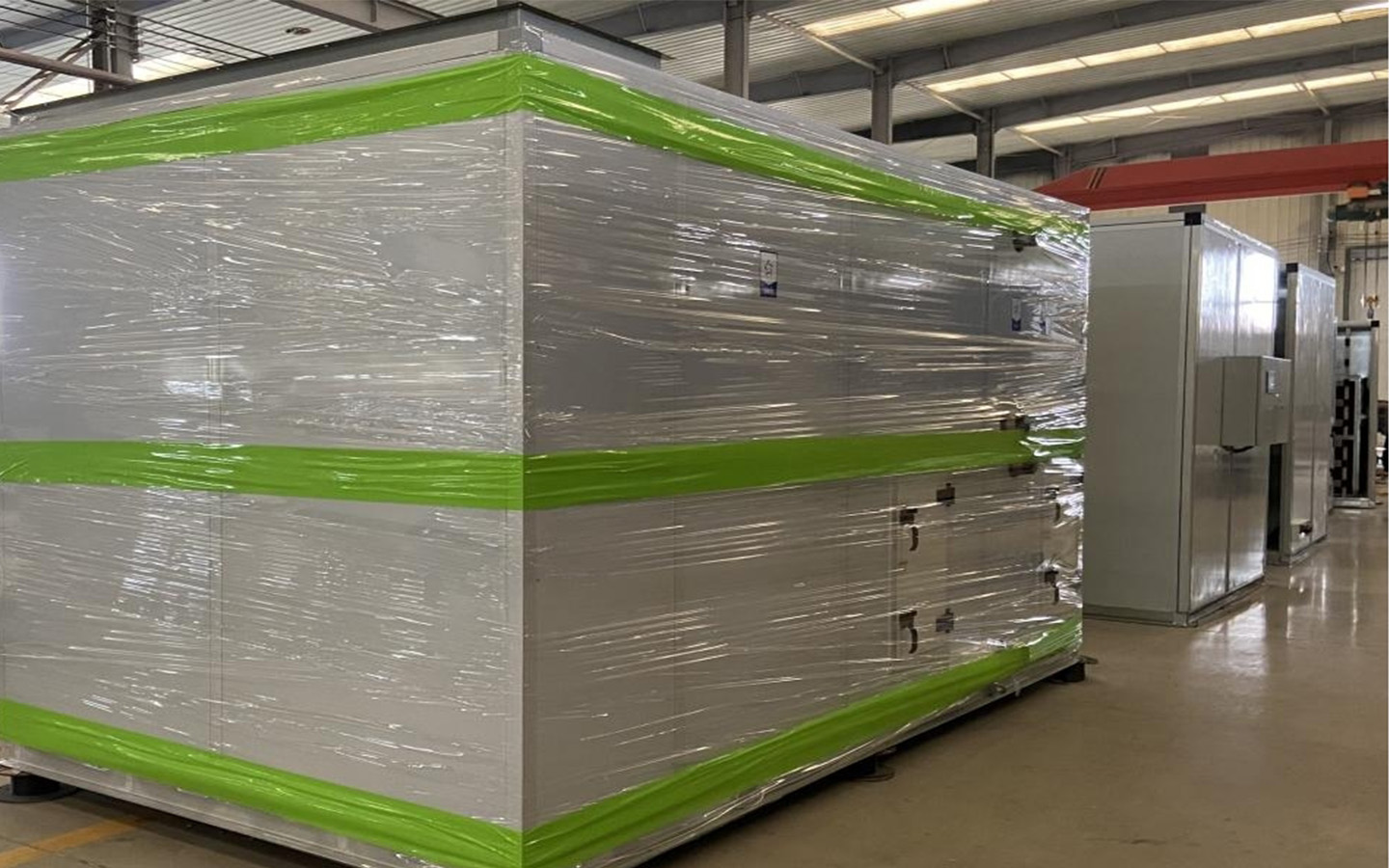






 Español
Español Русский
Русский Tiếng Việt
Tiếng Việt 中文
中文 suomi
suomi Français
Français Português
Português English
English Deutsch
Deutsch Français
Français Español
Español Italiano
Italiano Português
Português Pусский
Pусский


